Sendible insights 4 Types of Influencers and Differences: Nano, Micro, Macro, Celebrity
Have you ever been scrolling Instagram and then stopped to see one of your favourite celebrities–or even someone with just a few thousand followers–pose with a product, shout out the brand, and offer you a discount code to use at checkout?
This is influencer marketing.
Brands worldwide collaborate with people who have built social followings of as little as 1,000 followers and as big as millions.
But before you DM Ariana Grande, Nicki Minaj, or even the new fitness model with 1,500 followers, you need to know which type of influencer will give you the most bang for your buck–a micro-influencer, macro-influencer, or celebrity.
This blog post will cover the following
- How can influencer marketing help you grow your business?
- What are the 4 types of influencers?
- What is a nano influencer?
- What is a micro influencer?
- What is a macro influencer?
- What is a celebrity influencer?
- Which type of influencer is the right choice for your business?
How can influencer marketing help you grow your business?
In 2025, influencer marketing isn’t just a trend—it’s a strategic shortcut to building trust, expanding your reach, and boosting revenue without having to start from scratch.
Here’s how it drives real growth:
1. Instantly reach audiences bigger than yours
One of the biggest advantages of influencer marketing is simple: you don’t have to wait to build your own massive following. Instead, you can tap into influencers' existing, highly engaged communities.
With 87% of consumers using social media to research products and 72% of Gen Z and Millennials following influencers ), it’s clear that creators play a critical role in shaping buying decisions.
And it’s not just younger audiences—45% of adults aged 65+ are active on social media, meaning influencers can help you reach all demographics with the right platform strategy.
Whether it’s a YouTube video, an Instagram Reel, or a TikTok tutorial, partnering with trusted creators fast-tracks your brand’s exposure to new audiences.
2. Grow your social media following organically
Good influencer collaborations don’t just drive one-time promotions—they build brand equity. When followers discover your brand through an influencer they trust, many will choose to follow you directly.
In fact, influencer marketing is one of the most effective ways to:
- Grow your audience
- Increase engagement
- Strengthen your social media presence across multiple platforms
Where are marketers focusing in 2025?
- 82%+ on Instagram
- 61% on Facebook
- 53% on TikTok
📈 Pro tip: When partnering with influencers, always include CTAs that encourage direct follows and interactions with your brand's profile.
3. Build brand awareness and long-term credibility
Influencers don’t just share products—they shape perceptions. Their followers look to them for trusted recommendations, inspiration, entertainment, and lifestyle ideas.
When an influencer endorses your brand, it sends a powerful signal:
- This brand fits my values
- This product is credible
- This company is worth supporting
Even if a sale doesn’t happen immediately, the exposure builds top-of-mind awareness. When their followers are ready to buy, your brand is already in their mental shortlist.
4. Drive sales and revenue
Influencers have influence for a reason—they can directly sway purchasing behavior.
Recent research from HubSpot shows that 37% of Gen Z consumers purchased something in the past three months based on an influencer’s recommendation
And it’s not just hype—the numbers back it up:
- Brands earn an average of $6.50 for every $1 invested in influencer marketing.
- Campaigns with strong influencer partnerships show higher lifetime value (LTV) customers and stronger brand loyalty over time.
By strategically using trackable links, QR codes, discount codes, and UTM parameters, brands can attribute revenue directly to specific influencer campaigns and optimise for even better results over time.
5. Save on advertising costs
Influencer marketing doesn’t just perform well—it’s also more cost-effective than many traditional advertising methods.
In 2024, influencer marketing elevated social media to the top of the advertising world, overtaking paid search with an impressive $247.3 billion, and is projected to reach $266.92 billion by the end of 2025, solidifying its position as the central hub of consumer influence and engagement.
Unlike traditional ads, influencer content is often repurposable—turning into social proof you can reuse across ads, landing pages, and email campaigns.
That means lower upfront costs, better long-term ROI, and faster traction with audiences that already trust the messenger.
What are the 4 types of influencers?
Influencers are often categorised by the size of their audience and the type of relationships they have with their followers. In 2025, brands typically group influencers into four main types:
-
Nano influencers (500–10,000 followers): Everyday consumers with small, highly engaged communities. They’re trusted voices within niche circles and often deliver authentic recommendations.
-
Micro influencers (10,000–50,000 followers): Specialised creators with loyal, targeted audiences. They usually focus on specific topics like fitness, beauty, travel, or tech, and drive strong engagement.
-
Macro influencers (50,000–500,000 followers): Larger-scale creators who have built significant followings through consistent content, often across multiple platforms. They offer brands broader reach with moderate engagement.
-
Celebrity influencers (500,000+ followers): High-profile personalities, including actors, athletes, and mainstream content creators. They provide massive visibility but often at a higher cost and with lower engagement rates compared to niche influencers.
Choosing the right type of influencer depends on your brand goals, target audience, budget, and campaign objectives—which we'll cover later in this guide.
What is a nano influencer?
A nano influencer is a content creator with a small but highly engaged audience—typically between 500 and 10,000 followers.
While their reach is more limited compared to larger influencers, nano influencers often deliver exceptionally high engagement rates because their communities are close-knit, personal, and built on genuine trust.
Brands choose nano influencers because:
-
Their endorsements feel authentic and less commercial
-
Their audience is often hyper-targeted around a niche interest
-
Collaborations are more affordable and often more flexible
-
They create relatable, real-world content that resonates
Nano influencers are ideal for:
-
Local businesses targeting a specific region
-
Niche brands (sustainable fashion, indie beauty, specialty fitness, etc.)
-
Early-stage campaigns focused on brand awareness and word-of-mouth marketing
In 2025, nano influencers are playing an even bigger role in influencer marketing strategies, as brands increasingly prioritize quality of connection over quantity of followers.
Pro tip: Partnering with multiple nano influencers can often outperform a single macro influencer campaign—at a fraction of the cost.
What is a micro influencer?
A micro-influencer has between 10,000 and 50,000 followers on a social media platform.
These influencers are much smaller than celebrities and macro-influencers (which we’ll discuss later), but they’re also more affordable.
InfluencerMarketingHub reports that most micro-influencers charge between $100-$500 per post. As a result, it’s no surprise that 44% of marketers say that the lower price is the biggest benefit of working with micro-influencers.
The only downside: they typically have a significantly smaller audience.
However, micro-influencers usually have a tremendously higher engagement rate – up to 60% higher than macro-influencers.
Engagement trumps quantity though – over 55% of marketers who run influencer marketing campaigns choose to invest in micro-influencers rather than celebrities or macro-influencers.
Let’s look at two examples of micro-influencers on Instagram.
First, we have @iyeloveslife, a vegan content creator who shares vegan recipes, skincare tips, animal rights activism, and more. She has a little over 48,000 followers, putting her at the higher end of the micro-influencer spectrum.
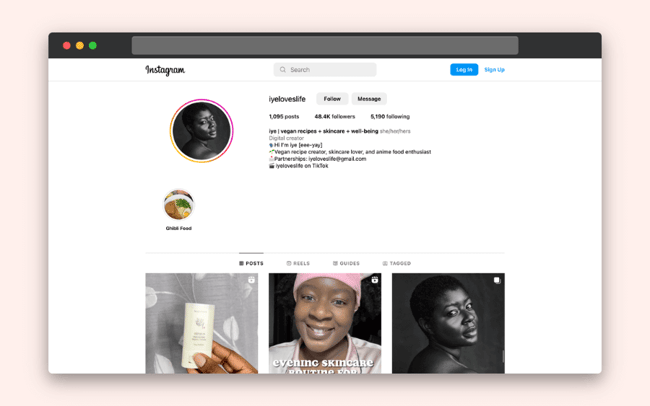 Source: @iyeloveslife
Source: @iyeloveslife
In her bio, she includes an email address that she uses specifically for brand partnerships.
Next, @_theaspiringboss is a micro-influencer and lawyer who posts about all things law school and the legal world. She has over 15,000 followers, placing her on the lower end of the micro-influencer spectrum.
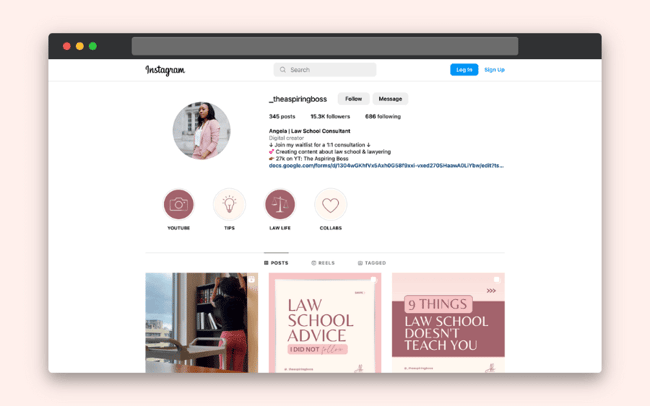 Source: @_theaspiringboss
Source: @_theaspiringboss
When people think of influencers, they often think of makeup, skincare, and fitness models. But as you can see from the last example, social media is beneficial for any industry.
Just be sure that you’re familiar with any regulations regarding social media in your industry. For example, there are various social media rules for lawyers or for industries like medicine that require a lot of cross-checking statistics and facts before posting anything online.

Practical Guide for Social Media Marketing for Law Firms.
What is a macro influencer?
A macro-influencer has over 50,000 followers on a social media platform.
For example, this is a fitness influencer and former competitive female bodybuilder on Instagram with 142,000 followers, which puts her in the macro-influencer category:
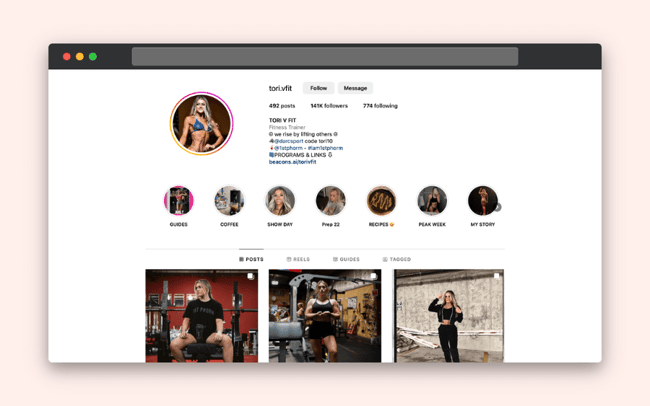 Source: @tori.vfit
Source: @tori.vfit
In her bio, she promotes two brands she works with, a supplement company called 1st Phorm and Darcsport, an activewear brand that’s well-known in the fitness community.
She also regularly posts pictures holding her favourite supplements from 1st Phorm or clothes from Darcsport, like in this post:
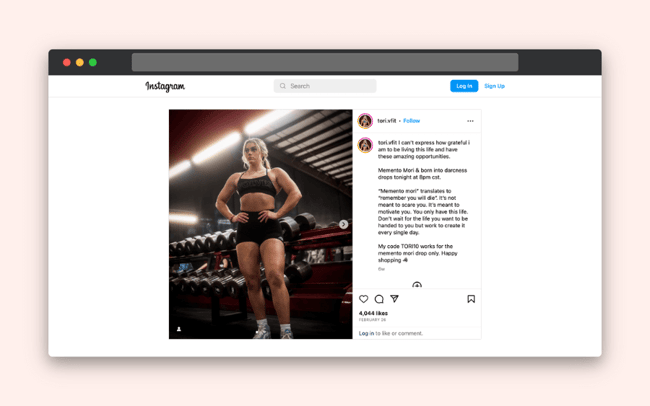
Another example of a macro-influencer is travel influencer @thewayfaress on Instagram, with 102,000 followers.
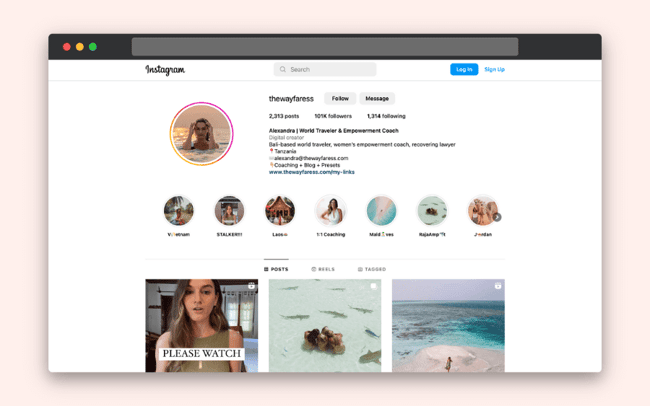 Source: @thewayfaress
Source: @thewayfaress
Even macro-influencers on the lower end of the follower spectrum have their fair share of brand collaborations, ambassadorships, and influencer campaign requests. But they’re far from the same.
“Over 10,000 followers” is a big range, especially since the next level up is “celebrity.”
As such, macro-influencers can charge vastly different prices for promotional posts and campaigns, largely depending on their number of followers.
Just for reference, InfluencerMarketingHub reports that the standard rates macro-influencers charge is anywhere from:
- $100-500 per post (in the 10,000-50,000 follower range)
- $500-5,000 per post (in the 50,000-500,000 follower range)
- $5,000-10,000 per post (500,000 - 1,000,000 followers)
Working with a macro-influencer (of any size) can lead to increased sales and skyrocketed brand awareness. But one of the definite cons is the price.
Small businesses or startups likely can’t afford macro-influencers with more than 10,000-50,000 followers and the highest engagement rates.
What is a celebrity?
A celebrity is sometimes called a “mega-influencer” in influencer marketing. They have over one million followers on social media and are usually verified because they appear in other parts of the entertainment industry, such as movies, reality TV programs, music, etc.
Examples of celebrities are big names like Justin Bieber, Nicki Minaj, Rihanna, and others.
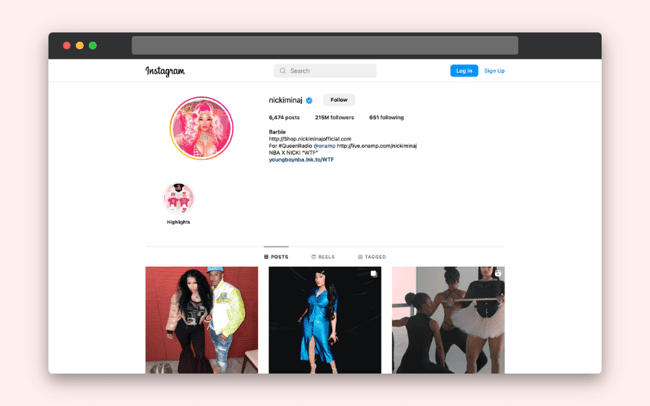 Source: @nickiminaj
Source: @nickiminaj
As you’d imagine, getting a celebrity to promote and endorse your product is much more challenging than micro or macro-influencers. Not to mention expensive.
But large followings aren’t always better.
The most recent data shows us that 50% of millennials trust influencers’ product endorsements and recommendations, but when it comes to celebrities, that trust drops to 38%.
This is because although celebrities have a huge number of followers, they have the lowest engagement rates. When it comes to social media, the larger the following, the lower the engagement. Think about it: how often do you get a response from your favourite celebrity?
So while having a celebrity advertise your business could be excellent for skyrocketing brand awareness, it’s probably not worth the money if your only goal is to increase sales.
Speaking of money, one promotional Instagram post from a celebrity (or mega-influencer) is $1,200 on average.
It’s not much different on TikTok, either. One TikTok post from a celebrity costs about $1,034 on average.
Which type of influencer is the right choice for your business?
The best type of influencer for your brand depends on your budget, goals, industry, and how closely you want to connect with your audience.
Here’s a quick guide to help you decide:
| Goal | Best influencer type |
|---|---|
| Brand awareness at scale | Macro or celebrity influencers can give your campaign huge reach, fast—ideal for product launches or national visibility. |
| High trust and engagement | Micro and nano influencers often deliver stronger engagement because their audiences feel more connected to them. |
| Niche targeting | Nano and micro influencers tend to have focused communities, making them perfect for reaching specific demographics or interest groups. |
| User-generated content (UGC) | Nano and micro influencers typically create relatable, authentic content that you can repurpose across your own channels. |
| Budget-conscious campaigns | Nano influencers offer the most cost-effective collaborations, especially when working with multiple creators at once. |
| Polished, professional production | Macro and celebrity influencers often have in-house teams and studio-quality content that aligns with premium branding. |
Pro tip: You don’t have to choose just one. A mix of influencer types can help you balance reach, trust, and content diversity—while allowing you to test what works best for your brand.
Still unsure where to start? Begin with a few micro influencers in your niche to test messaging, gather insights, and build long-term partnerships that scale.
Freya Laskowski
Freya is an SEO consultant that helps brands scale their organic traffic with content creation and distribution. She is a quoted contributor in several online publications, including Business Insider, Fox Business, Yahoo Finance, and the Huffington Post. She also owns CollectingCents- a personal finance blog that she grew from the ground up.
You can reach out to her at freya@collectingcents.com
Text copied!


